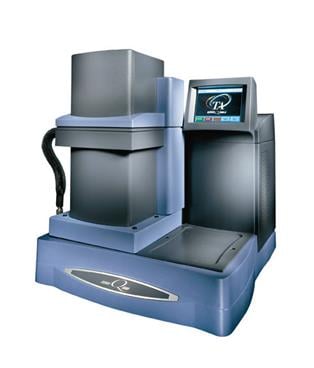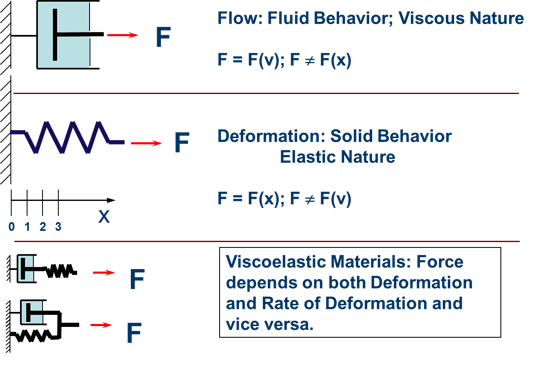By Samad Erogbogbo, Fauske & Associates (FAI)
Simply put, dynamic mechanical analysis (DMA) is a state-of-the-art technique that is used to study and characterize the mechanical properties of a wide range of materials. See Figure 1 below for an image of the machine used by Fauske & Associates, (FAI) for DMA. Many materials, including polymers, are viscoelastic. That is, they behave both like an elastic solid and a viscous fluid. For viscous materials the shear and tensile stress are a function of velocity whereas for elastic materials, the stresses are a function of deformation. A depiction of the viscoelastic nature of materials is presented in Figure 2. DMA machines differ from other mechanical testing devices in two important ways. First, typical tensile test devices focus only on the elastic component. In many applications, the viscous component is critical. It is the viscous component that determines properties such as impact resistance. Second, tensile test devices work primarily outside the linear viscoelastic range. DMA works primarily in the linear viscoelastic range and is therefore more sensitive to material’s chemistry and microstructure. DMA measures the viscoelastic properties using either transient or dynamic oscillatory tests. Further, these tests can typically be performed at the expected conditions the materials will be exposed to while in service.
The most common test is the dynamic oscillatory test, where a sinusoidal stress (or strain) is applied to the material and a resultant sinusoidal strain (or stress) is measured. Also measured is the phase difference, δ, between the two sine waves. The phase lag will be 0° for purely elastic materials and 90° for purely viscous materials. However, viscoelastic materials (e.g. polymers) will exhibit an intermediate phase difference. From the applied stress and the measurement of δ and strain, the storage modulus, E’, and loss modulus, E’’, can be calculated. The storage modulus (E’) is the elastic component and related to the stiffness of the material. The loss modulus (E’’) is the viscous component and is related to the ability of the material to dissipate mechanical energy through molecular motion. The tangent of the phase difference, or tan δ, is another common parameter that provides information on the relationship between the elastic and inelastic components. The complex modulus (sometimes referred to as dynamic modulus), E*, is calculated using the storage modulus and the loss modulus.
Transient tests include creep and stress relaxation. In creep, a stress is applied to the sample and held constant while deformation is measured vs. time. After some time, the stress is removed and the recovery is measured. In stress relaxation, a deformation is applied to the sample and held constant, and the degradation of the stress required to maintain the deformation is measured versus time. See below for other meaningful creep and stress relaxation parameters that can be obtained from DMA.
The DMA machine can perform many unidirectional types of tests that are classified as dynamic oscillatory tests or transient tests with these general test configurations: Cantilever, Three-Point Bend, Tension, and Compression. The following are brief descriptions of the unidirectional tests the DMA machine can perform:
- Transient
- Stress Relaxation
- Deformation applied instantaneously ⇒ Force measured as a function of time
- Deformation (mm) converted to Strain (e), Force (N) to Stress (t)
- Stress (t)/Strain(e) = Modulus (E)
- Creep
- Force applied instantaneously ⇒ Deformation measured as a function of time
- Force to Stress (t), Deformation converted to Strain (e)
- Strain (e)/Stress (t) = Compliance (D)
- Dynamic
- Strain Ramp
- Strain increased linearly or exponentially with time
- Iso-Strain
- Strain held constant as temperature is varied
- Stress Ramp
- Stress increased linearly or exponentially with time
- Controlled Stress
- Stress held constant as temperature is varied
As mentioned earlier, the DMA is used to study and characterize mechanical properties of materials. The characterization is however not limited to stand-alone materials; the DMA could also be used to characterize assembled materials to understand the in-service behavior for the as-assembled configuration. To fully understand materials or assembled components, engineers sometimes use short-term test information obtained from a DMA test to project long-term performance to avoid unexpected failures for a specific application.
DMA Use Cases
The results obtained from the DMA machine can be used for a variety of purposes including some already highlighted above. Here are a few more potential use cases:
- Determining material properties for engineered materials to be used as input in Finite Element Modeling (FEM) or other analyses.
- Characterization and prediction of failure modes for assembled components at service conditions.
- Root cause analysis investigations – The in-service load on a component or material could be simulated to determine the evolution of the material properties before failure occurred.

Figure 1 TA Instruments Q800 Dynamic Mechanical Analysis (DMA) Machine

Figure 2 Viscoelastic nature of materials
For more information or discussion, please comment here or contact us at info@fauske.com. www.fauske.com.


